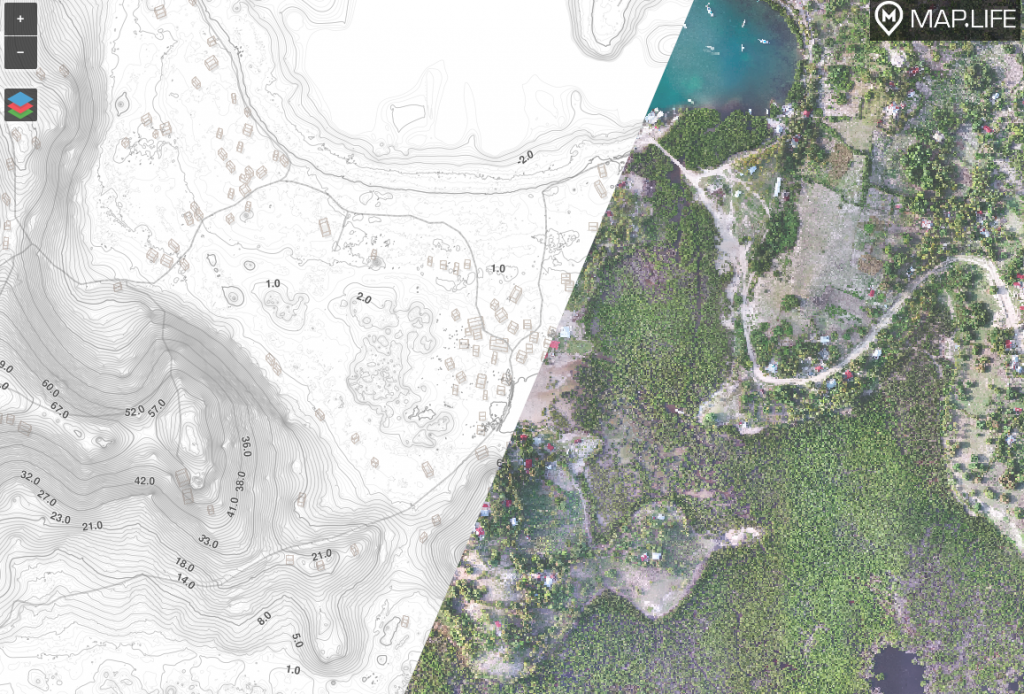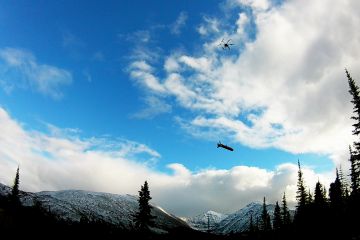Ethos Geological recently performed a drone survey for a company covering a large area of interest in Haiti. From high winds to sunburns and beautiful white sand beaches, this project tested our faculties in many ways! Read on to find out some of the most amazing results from the trip, the processing, and the delivery.
1. Our drone survey covered 20 square miles.
Why is this unbelievable? Because there isn’t yet a computer setup or software that can easily handle such large projects at this resolution off-the-shelf, or really any data collected at 4 cm / pixel resolution covering an area this size.
We spent seven days collecting over 21,000 images from a drone flying at an altitude of 170m, totalling 200 GB of raw data / 1 TB processed for the elevation photgrammetry component of the survey. The final run of the processing took 21 days to complete using an incredibly large server designed just for this project… it’d be difficult to build or find anything larger, even leveraging Google or Amazon’s cloud offerings.
Posts and comments online describe ‘large’ photogrammetry projects at merely 3,000 – 5,000 images. I’m incredibly impressed with our capabilities and now we’re ready for more.
2. Haitian cuisine is outstanding. And fresh.
Pikliz & griot. Face-melting delicious and inexpensive (if you provide your own pig).
Pikliz is a lot like ‘coleslaw’ on the mainland North America, but without mayo, and with scotch bonnet peppers. Sweeter than habeneros, but every bit as spicy.
Griot is cubed pork shoulder brined in something similar to pikliz, then boiled, and flash-fried. Think crunchy outside with very tender inside, all flavored in the spirit of Haiti thanks to the brining. (Though recipes call it a ‘marinade’, this couldn’t be further from the truth… brines actually work).
When we returned the recipe had to be shared, and here is the best example of both!
Most all of the food is prepared daily. Carrots, oranges, peppers, goat, conch- if it’s on your plate and you are are just about anywhere other than a hotel, there is a good chance it was harvested only a few hours ago.
3. The coastlines are postcards.
’nuff said

4. You insult people by doing it yourself.
Don’t worry, it’s a cultural thing. Carry something to the boat? Let me help you. Wash clothes? Let me help you. Walk up the hill? Let me accompany you. Rent a boat? I know a guy. Travel around the island? I’ll come with four friends.
Just make sure to travel with a heap of one’s and five’s, and be liberal handing them out …At the end of the trip.
…Unless you’re buying a round of Prestige for everyone, in which case, ask a local to buy them for you, so you end up with 3x as many beers to share.
5. No refrigerators, plenty of cell phones.
Initially easy to adapt to the appearance of native Haitians looking as if they belonged in Anywhere, USA- the aid provisions seem to be effective- we quickly became aware of the dichotomy between the subconscious expectations of spoken English and our homeland amenities arising from our similar style of clothing, against the reality of: no power, no refrigeration, barefoot, and women carrying water in buckets on their heads- without spilling.
Except, of course, the solar panels that pepper the island and generators (far less abundant) supplying amps for the cell phones that everyone has in their pocket. Large cell towers? Check. Groceries stores? Nope. Which leads back to the food, above.
Another note on cell phones in Haiti: Google Translate’s ‘Haitian-Creole’ is about as tough to use as performing arm-waving acrobatics, so go learn yourself some French.

6. You can get a lot of immunizations, but do you need to?
When your physician / friend / whomever talks to you about preparations for travel beforehand, remember that there are two Haitis: Port au Prince, and almost everywhere else.
Luckily for us, our client picked us up at PAP with a sikorsky and delivered us into the countryside (thank you, Colibri-Haiti) where the food, bottled water, and swimming in the ocean were absolutely no problem for us Montanans… by-passing the activism and riots where we would have be an easy mark for just about anyone.
Our drone survey, while beautiful and professional, is simply another harbinger of this movement.

7. Haiti is changing.
The countryside is gorgeous, and development corporations know it. Gentrification here is a conclusion from a question people don’t ask, but invite. Our northern ‘1st world’ culture has already established footing in people’s homes through soccer, advertisements, online, and on the clothes and other products we donate.
Our drone survey, while beautiful and professional, is simply another harbinger of this change.
The only doubts remaining are will the people of Haiti accept – or participate in- – the change? (They are fiercely loyal to certain pieces of heritage, yet fiercely accepting of outside influence, yet fiercely resistant to long-game planning). Will the government interfere for good or for greed?

8. We pulled off a massive drone survey- in Haiti!
A small geological consulting firm from Montana flew a very large survey for a sizeable corporation in a third-world country. No incidents, on time, with good accuracy and within budget. Then hosted it on Map.Life for clients to view on their mobile phones. I’m very proud our drone survey products, Alex Milton and team, and what we managed to do with some very slick software engineering.
Imagine what we can do for you.

